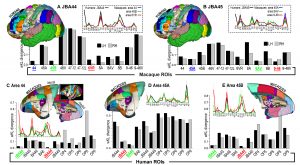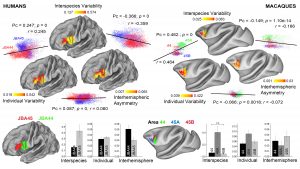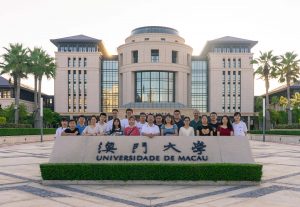A research team led by Prof Yuan Zhen in the Centre for Cognitive and Brain Sciences (CCBS) and the Faculty of Health Sciences, University of Macau (UM), recently made a breakthrough in the investigations of language connectome and cross-primate comparison. For the first time, the team successfully identified homologous mapping relationships between voxels within the human and macaque Broca’s area. The research results are expected to enhance people’s understanding of structural connectivity modification within the Broca’ area and shed light on the neural mechanisms of underlying human-specific high-level language functions. The study has been published in NeuroImage, the top journal in the field of neuroimaging.
Macaque monkeys are classic translational animal models of humans. Cross-species quantitative comparisons of structural connectivity of the Broca’ area between the two species can help explore human-specific high-level cognitive functions (e.g., language). By analysing the reliability of knowledge transfer, these animal models can be used more efficiently. However, cortical borders of homologous areas across primates are defined ambiguously in existing literature, which hinders the research progress in cross-primate comparison. Moreover, even though cross-species comparisons of single tracts (e.g., arcuate fiber) have produced interesting findings, the comparisons of whole-brain connections are still scarce.
In the study, the research team used 23 pairs of homologous white matter bundles to characterise the structural connectivity patterns of voxels within the Broca’s area. They then localised the homologous voxels based on the similarity of connectivity patterns, and inspected the inter-species, individual, and inter-hemispheric connectivity differences as well as gray matter (GM) deformation. The team also performed partial correlation analyses to inspect the relationships between the three types of connectivity variability after controlling the influence of GM deformation.
According to the findings, the inter-species and inter-subject variabilities exhibited positive correlation in both primates, yet negative relationship was identified between the inter-species variability and inter-hemispheric asymmetry. In particular, higher inter-species and individual variabilities were detected in the anatomically defined pars triangularis, and a higher asymmetry was revealed in the anatomically defined pars opercularis. At the tract level, functional roles related to the dorsal stream in speech production showed higher species and hemispheric specialisations, while those related to the ventral stream in speech comprehension were more conservative and bilaterally organised. These research results could enhance people’s understanding of structural connectivity modification within the Broca’ area, and shed light on the neural mechanisms of underlying human-specific high-level language functions.
The study was led by Prof Yuan. Postdoctoral fellow Xia Xiaoluan is the first author. PhD candidate Gao Fei also made important contributions to the study. This work was jointly supported by the Science and Technology Development Fund, Macau SAR (File no.: 0020/2019/AMJ & 0011/2018/A1) and the University of Macau (File no: MYRG2020-00067-FHS, MYRG2019-00082-FHS and MYRG2018-00081-FHS). For the full-text version of the study, please visit https://www.sciencedirect.com/science/article/pii/S1053811921008569?via%3Dihub.
| Source: Institute of Collaborative Innovation | |
| Media Contact Information: | |
| Communications Office, University of Macau | |
| Albee Lei | Tel: (853) 8822 8004 |
| Judite Lam | Tel: (853) 8822 8022 |
| Email: | prs.media@um.edu.mo |
| UM 40th | |
| anniversary website: | 40.um.edu.mo |
| UM Website: | www.um.edu.mo |

Localisation of homologous voxels between humans and macaques based on minimal structural connectivity differences

Inter-species, individual, and inter-hemispheric structural connectivity differences of voxels within the Broca’s area and their relationships

Yuan Zhen (5th from left in the front row), Xia Xiaoluan (4th from right in the back row), Gao Fei (1st from left in the front row)
